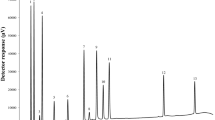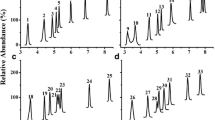Abstract
A method for the determination of free arginine, glutamine, and β-alanine in nutritional products and dietary supplements is described. The amino acids are derivatized with the fluorescent tag 9-fluorenylmethoxycarbonyl (FMOC), and the derivatives are then determined by reversed phase HPLC. Method suitability was defined by experimental assessments of linearity (R 2 > 0.999), precision (day-to-day RSD ≤ 1.0%), accuracy (spike recoveries=98.7%–101.8%, n = 18), and selectivity (baseline resolution from the other common amino acids). The method provides for an accurate and precise quantification of the three amino acids, when present at concentrations >0.2% (w/w) in nutritional products and dietary supplements. Assessments of free l-glutamine stability in three different reconstituted powder products, as performed by the method, found recoveries >97% through 24 h at room temperature.



Similar content being viewed by others
References
Andreasen AS, Pedersen-Skovsgaard T, Mortensen OH, van Hall G, Moseley PL, Pedersen BK (2009) The effect of glutamine infusion on the inflammatory response and HSP70 during human experimental endotoxaemia. Crit Care 13:R7
Appleton J (2002) Arginine: clinical potential of a semi-essential amino acid. Altern Med Rev 7:512–522
Arii K, Kobayashi H, Kai T, Kokuba Y (1999) Degradation kinetics of l-glutamine in aqueous solution. Eur J Pharm Sci 9:75–78
Bank RA, Beekman B, Tenni R, TeKoppele JM (1997) Pre-column derivatisation method for the measurement of glycosylated hydroxylysines of collagenous proteins. J Chromatogr A 703:267–272
Baxter JH, Phillips RR, Dowlati L, Johns PW (2004) Glutamine in commercial liquid nutritional products. J Agric Food Chem 52:4963–4968
Creighton TE (1993) Proteins: structures and molecular properties, 2nd edn. Freeman, New York
Derave W, Ozdemir MS, Harris RC, Pottier A, Reyngoudt H, Koppo K, Wise JA, Achten E (2007) β-Alanine supplementation augments muscle carnosine content and attenuates fatigue during repeated isokinetic contraction bouts in trained sprinters. J Appl Physiol 103:1736–1743
Dhingra D, Parle M, Kulkarni SK (2006) β-Alanine protects mice from memory deficits induced by ageing, scopolamine, diazepam, and ethanol. Ind J Pharm Sci 68:216–221
Ericson M, Clarke RBC, Chau PP, Adermark L, Soderpalm B (2010) β-alanine elevates dopamine levels in the rat nucleus accumbens: antagonism by strychnine. Amino Acids 38:1051–1055
Furst P, Stehle P (2004) What are the essential elements needed for the determination of amino acids required in humans. J Nutr 134:1558S–1565S
Haynes TE, Li P, Li X, Shimotori K, Sato H, Flynn NE, Wang J, Knabe DA, Wu G (2009) l-Glutamine or l-alanyl-l-glutamine prevents oxidant- or endotoxin-induced death of neonatal enterocytes. Amino Acids 37:131–142
Heyland DK, Novak F, Driver JW, Jain M, Su X, Suchner U (2001) Should immunonutrition become routine in critically ill patients? JAMA 286:944–953
Hoffman JR, Ratamess NA, Faigenbaum AD, Ross R, Kang J, Stout JR, Wise JA (2008) Short duration β-alanine supplementation increases training volume and reduces subjective feelings of fatigue in college football players. Nutr Res 28:31–35
Ishiwari K, Mingote S, Correa M, Trevitt JT, Carlson BB, Salamone JD (2004) The GABA uptake inhibitor β-alanine reduces pilocarpine-induced tremor and increases extracellular GABA in substantia nigra pars reticulate as measured by microdialysis. J Neurosci Meth 140:39–46
Jambor A, Molnar-Perl I (2009) Amino acid analysis by high-performance liquid chromatography after derivatization with 9-fluorenylmethyloxycarbonyl chloride. Literature overview and further study. J Chromatogr A 1216:3064–3077
Jordan T, Lukaszuk J, Misic M, Umoren J (2010) Effect of beta-alanine supplementation on the onset of blood lactate accumulation (OBLA) during treadmill running: pre/post 2 treatment experimental design. J Int Soc Sports Nutr 7:20–26
Kearns LR, Phillips MC, Ness-Abramof R, Apovian CM (2001) Update on parenteral amino acids. Nutr Clin Pract 16:219–225
Khan K, Hardy G, McElry B, Elia M (1991) The stability of l-glutamine in total parenteral nutrition solutions. Clin Nutr 10:193–198
Novak F, Heyland DK, Avenell A, Drover JW, Su X (2002) Glutamine supplementation in serious illness: a systematic review of the evidence. Crit Care Med 30:2022–2029
Ottenheym HH, Jenneskens PJ (1970) Synthetic amino acids and their use in fortifying foods. J Agric Food Chem 18:1010–1014
Perez-Barcena J, Crespi C, Regueiro V, Marse P, Raurich JM, Ibanez J, de Lorenzo-Mateos AG, Bengoechea JA (2010) Lack of effect of glutamine administration to boost the innate immune system response in trauma patients in the intensive care unit. Crit Care 14:R233
Robinson EK, Kelly DP, Mercer DM, Kozar RA (2008) Differential effects of luminal arginine and glutamine on metalloproteinase production in the postischemic gut. JPEN-Parenter Enteral 32:433–438
Sale C, Saunders B, Harris RC (2010) Effect of beta-alanine supplementation on muscle carnosine concentrations and exercise performance. Amino Acids 39:321–333
Samocha-Bonet D, Wong O, Synnott EL, Piyaratna N, Douglas A, Gribble FM, Holst JJ, Chisholm DJ, Greenfield JR (2011) Glutamine reduces postprandial glycemia and augments the glucagon-like peptide-1 response in type 2 diabetes patients. J Nutr 141:1233–1238
Shih F (1985) Analysis of glutamine, glutamic acid and pyroglutamic acid in protein hydrolysates by high-performance liquid chromatography. J Chromatogr 322:248–256
Souba WW, Smith RJ, Wilmore DW (1985) Glutamine metabolism by the intestinal tract. JPEN-Parenter Enteral 9:608–617
Twardzik DR, Peterkofsky A (1972) Glutamic acid as a precursor to N-terminal pyroglutamic acid in mouse plasmacytoma protein. Proc Natl Acad Sci USA 69:274–277
Wu G (2009) Amino acids: metabolism, functions, and nutrition. Amino Acids 37:1–17
Zhou M, Martindale RG (2007) Arginine in the critical care setting. J Nutr 137:1687S–1692S
Author information
Authors and Affiliations
Corresponding author
Rights and permissions
About this article
Cite this article
Baxter, J.H., Johns, P.W. Determination of Free Arginine, Glutamine, and β-alanine in Nutritional Products and Dietary Supplements. Food Anal. Methods 5, 821–827 (2012). https://doi.org/10.1007/s12161-011-9318-x
Received:
Accepted:
Published:
Issue Date:
DOI: https://doi.org/10.1007/s12161-011-9318-x




